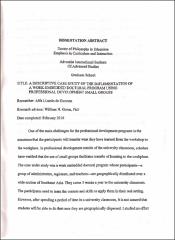| dc.description.abstract | One of the main challenges for the professional development programs is the
assurance that the participants will transfer what they have learned from the workshop to
the workplace. In professional development outside of the university classroom, scholars
have verified that the use of small groups facilitates transfer of learning to the workplace.
The case under study was a work embedded doctoral program whose participants-a
group of administrators, registrars, and teachers-are geographically distributed over a
, wide section of Southeast Asi~. They come 5 weeks a year to the university classroom.
The participants need to learn the content and skills to apply them in their real setting.
However, after spending a period of time in a university classroom, it is not assured that
students will be able to do that once they are geographically dispersed. I studied an effort
that was implemented to offer a solution to that education problem. The institution-in
which the case I studied took place-implemented ·the use of professional development
small groups to improve the likelihood that the work embedded program would succeed.
This study uses a descriptive qualitative ·case study method which is based on a
variety of data sources: (a) the Growth States Interview, (b) the Gregorc Mind Styles
Delineator, (c) the Innovation Configuration, (d) observations, (e) interviews, (f) archival
data and document review, and (h) review of related literature. The purpose of this study
was to describe the initial phase of the implementation of a work embedded doctoral
program and the use of small groups that can effectively function as a means to facilitate
the transfer of learning from the university classroom to the workplace in a
geographically distributed setting.
The data gathered showed that the professors had a positive attitude about the _
program and were willing to make accommodations to the curriculum in order to reach
the goals of the courses. These curricular accommodations were related to the time
dedicated to the course and the continued assignments. There were evidence students
received support and help from the professors.
The findings showed that the work embedded doctoral cohort program is a
complex and interesting design and all its critical components are related. Therefore, it is
very important that all the individuals who are involved understand these components. In
order to sustain the professional development small groups and engage the students in
those groups, a social relationship needs to be built. This relationship is critical for the
transfer of learning to the workplace and is built through collaboration among the
professors and the students. | en_US |

